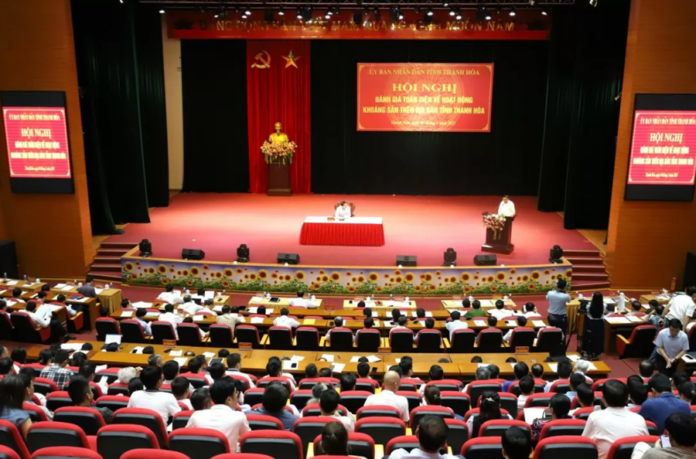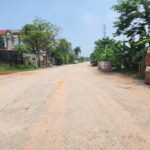The construction industry in Thanh Hoa has been facing significant challenges since the beginning of 2025, with a severe shortage of essential building materials such as graded stone, construction sand, and fill dirt. This scarcity has driven up material prices and greatly impacted the progress of infrastructure and civil engineering projects in the province.
IMPACT ON CONSTRUCTION PROJECT PROGRESS
On May 5, 2025, the People’s Committee of Thanh Hoa province organized a comprehensive conference to evaluate mineral activities in the province. The conference was fully attended by provincial leaders, leaders of provincial departments, branches, and sectors; leaders of districts, towns, and cities; and leaders of the provincial Business Association and the Thanh Hoa Stone Association. Also present were enterprises in mineral exploitation and processing and construction contractors using minerals as building materials in the province.
According to the province’s assessment, mineral activities in the province have had many shortcomings and limitations, with three main issues. First, the sharp increase in material prices compared to the end of 2024 has revealed weaknesses in price management. Fill dirt, graded stone, and construction sand prices have all surged, with sand prices increasing by about 30%, far exceeding the price framework announced by the authorities.

Secondly, many projects do not have nearby material sources and have to transport materials from far away, increasing costs by several dozen percent. This not only delays progress but also reduces the efficiency and profitability of enterprises.
Finally, violations in mineral exploitation are becoming more complex. Some enterprises have exceeded their boundaries and capacity, operated without proper designs, delayed environmental protection procedures, illegally exploited river sand and fill dirt, declared incorrect output, sold without listing prices, caused pollution, and damaged roads. This situation has caused public dissatisfaction and harmed legitimate enterprises.
At the conference, Mr. Nguyen Doan Anh, Secretary of the Provincial Party Committee, remarked that the feedback from enterprises indicated a significant increase in construction material prices in Thanh Hoa province, affecting the construction of projects and people’s housing construction.
This situation is worrisome as it may delay the implementation of projects, especially in industrial infrastructure, urban development, and road transport. It will also affect the province’s investment environment and attract investment projects. Furthermore, it will impact the 15,326 households in the program to eliminate temporary and dilapidated houses as directed by the Government and the Provincial Party Committee and People’s Committee.

At the conference, construction contractors and mineral enterprises proposed many initiatives to “cool down” construction material prices. The enterprises suggested the need to update the construction material price list promptly, reflecting the actual market movements, especially in areas with high volatility.
At the same time, relevant departments and sectors should establish a coordinated mechanism to streamline administrative procedures for enterprises, especially in fields such as investment, construction, land, and minerals.

The enterprises also requested the People’s Committee of Thanh Hoa province to balance the reserves of mines that must be supplied to avoid a shortage of construction materials for projects. This situation has led to contractors buying materials from unlicensed mines at high prices, resulting in non-standard quality products that cause disruptions and losses for enterprises.
“COOLING DOWN” SOLUTIONS
At the conference, Mr. Le Duc Giang, Vice Chairman of the Provincial People’s Committee, stated that to ensure a stable and continuous supply of construction materials to meet the demands of construction projects in the province, both in the short and long term, mineral exploitation and processing enterprises must continue to strictly exploit minerals according to their licensed limits.
They must also comply with regulations on environmental protection, security and order, labor safety, and related laws. Enterprises should strictly declare and sell at listed prices, refrain from hoarding, arbitrarily raising prices, or forcing sales. They must also fulfill their contracts with mineral-using enterprises and contractors, providing sufficient quantities of materials according to the contracts to meet the progress of project implementation, especially for major and key projects of the province.

Enterprises are required to declare and pay taxes and environmental protection fees according to the actual output; report statistics and inspect mineral reserves as prescribed; and absolutely not allow the loss of mineral resources.
Regarding planning and demand forecasting, the Vice Chairman of the Provincial People’s Committee assigned the Department of Construction to review and accurately assess the demand for construction materials in the province in 2025 and the period of 2026-2030. This assessment should be based on the survey results, evaluating the operating capacity of mineral mines in the province and the provincial mineral planning to advise and propose a list of mineral exploitation and processing projects that need to be organized for auction and exploitation in the coming time.
For the 557 mines of common construction minerals in the province according to the Planning for the period of 2021-2030, with a vision to 2045, it is necessary to continue to inspect and review to ensure that the data in the planning is consistent with the reality, serving as a basis for implementing the procedures for auction, licensing, and mineral exploitation. At the same time, continue to inspect and detect mines of construction minerals in the province, and if qualified, implement the procedures for updating and supplementing them into the Planning of the province according to regulations.
For fill dirt, it is necessary to survey and detect fill dirt mines and build a plan for the use of fill dirt in the province until 2030, as a basis for orienting licensing and exploitation, ensuring efficiency and economy and avoiding the phenomenon of investors applying for licenses indiscriminately, affecting the landscape and environment and wasting resources.
Regarding the licensing of mineral exploration and exploitation, the Vice Chairman of the Provincial People’s Committee assigned the Department of Agriculture and Environment to review the overall procedures and processes related to the licensing of mineral exploration and exploitation; and to minimize the time for exploration and exploitation licensing procedures in the province to soon have a source of materials to supply to key projects and other related projects.
VietinBank: Leading the Pack with Impressive Operating Income Figures
As per VietinBank’s Q3 2024 financial statements and recently released reports from other banks, VietinBank has emerged as the leader in Vietnam’s banking sector in terms of operating income (TOI) and pre-provision profit from business operations. This achievement underscores the bank’s effective utilization of its earning assets to generate robust revenue and healthy profits.
Unlocking the Potential: Eight Real Estate Projects in Ho Chi Minh City Freed from Legal Constraints
Since its inception, the Ho Chi Minh City Task Force has reviewed and addressed the legal issues of 30 real estate projects. Of these, 8 projects have been completely freed from legal entanglements.





















